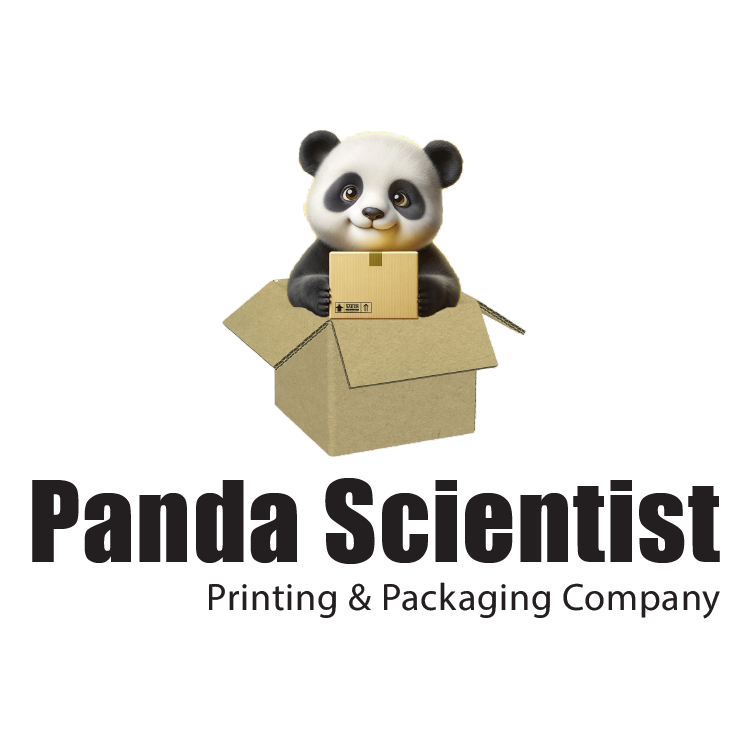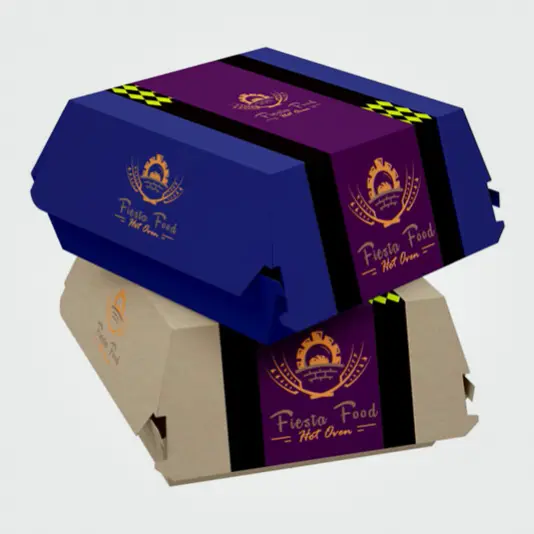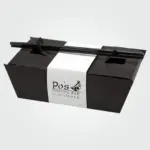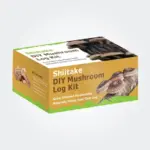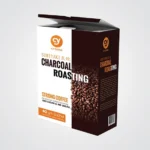Burger Boxes
Custom Burger Boxes
Relish the fusion of taste and presentation with our Custom Burger Boxes. Crafted to cradle your culinary masterpiece, these boxes seal in the freshness and flavors of every delectable burger. Whether it’s a classic beef patty, a gourmet chicken creation, or a vegetarian delight, our packaging ensures the burger’s integrity from kitchen to consumer. Designs range from vintage diner styles to contemporary minimalistic patterns, reflecting the diverse world of burger aficionados. Prioritizing sturdiness with style, our Custom Burger Boxes make every bite a testament to the burger’s craftsmanship and the impeccable taste of its presentation.
Burger Boxes Market Share in The United States
Burger boxes are containers to hold and transport burgers from restaurants or fast-food chains to customers. Burger packaging, in general, plays a vital role in the food industry, as it helps maintain the quality and freshness of the product while ensuring safe and hygienic delivery to the end consumer. In this article, we will delve deeper into the importance of burger packaging and the history of burger packaging in the United States. The future of burger boxes in the United States looks promising as the demand for sustainable and eco-friendly packaging solutions grows. With an increasing number of consumers becoming environmentally conscious and concerned about the impact of plastic and other non-biodegradable materials on the planet, there is a need for more sustainable packaging options.
The market for burger boxes in the United States is expected to grow significantly in the coming years, driven by factors such as the rising popularity of fast food and the increasing demand for takeout and delivery services. According to a report by Grand View Research, the global foodservice packaging market, which includes burger boxes, is expected to reach $84.33 billion by 2025, growing at a compound annual growth rate (CAGR) of 5.1%.
Importance of Burger Packaging in the Food Industry
Burger packaging serves several vital purposes in the food industry. Firstly, it helps preserve the quality and freshness of the product by protecting it from external factors such as moisture, air, and light. This is crucial, as burgers can quickly lose flavor and texture when exposed to these elements. Furthermore, proper packaging helps prevent contamination and the spread of foodborne illnesses by ensuring that the burgers are handled and transported safely and hygienically. In addition to these functional benefits, burger packaging also plays a crucial role in branding and marketing. A well-designed and visually appealing packaging can attract customers and create a positive impression of the brand. Moreover, it can help distinguish the product from competitors and build brand recognition.
Brief History of Burger Packaging in the United States
The history of burger packaging in the United States can be traced back to the early 20th century when fast food chains started to gain popularity. Initially, burgers were served in paper wrappers, which were not very effective in preserving the quality of the product. As the industry grew, so did the need for better packaging solutions. In the 1950s, the introduction of foam containers revolutionized the fast-food industry. These containers were lightweight, affordable, and excellent at insulating food, which helped preserve its quality during transportation. However, they were not very eco-friendly, and concerns about their environmental impact led to the development of new, more sustainable packaging materials.
Regarding market share, traditional packaging materials such as foam and plastic are still widely used in the fast food industry. However, there is a growing trend towards more sustainable alternatives, such as paper-based solutions and biodegradable materials. Many fast food chains, including McDonald’s and Burger King, have started introducing more eco-friendly packaging options, and more companies are expected to follow suit. The rise of e-commerce and the increasing popularity of food delivery services also drive the demand for packaging solutions for transportation and delivery. This has led to the development of specialized packaging solutions that keep food hot and fresh during transit while being easy to handle and transport.
Types of Burger Boxes and Packaging
Burger boxes come in various types and materials, each offering different benefits and drawbacks. Below are some of the most common types of burger boxes and packaging available:
Paper-based burger boxes
These boxes are made of paperboard or cardboard and are lightweight and eco-friendly. They are also customizable, allowing brands to print their logos and designs on the box. However, they may not be as durable as other materials and can be susceptible to moisture.
Plastic-based burger boxes
These boxes are made of plastic and are highly durable, providing a longer shelf life than other materials. However, they are not environmentally friendly and are not biodegradable. They are also more expensive than other materials.
Foam-based burger boxes
These boxes are made of expanded polystyrene (EPS) foam and are highly effective at insulating the burger, keeping it hot and fresh for longer. They are also affordable and lightweight. However, they are not recyclable and can be harmful to the environment.
Biodegradable and compostable burger boxes
These boxes are made of sugarcane, bamboo, and cornstarch and are fully biodegradable and compostable. They are also highly customizable, allowing brands to print their logos and designs on the box. However, they can be more expensive than other materials and may not be as durable.
Customized burger boxes
These highly customizable boxes allow brands to create unique designs and shapes that reflect their identity. They can be made of any material, including paper, plastic, and foam, and can be tailored to specific sizes and shapes.
Aluminum foil burger boxes
These boxes are made of aluminum foil and are lightweight, durable, and heat-resistant, making them ideal for keeping burgers warm during transport. They are also recyclable and can be customized with branding and designs.
Cardboard clamshell burger boxes
These boxes are made of cardboard and are shaped like a clamshell, providing a convenient way to store and transport burgers. They are lightweight, easy to open and close, and can be customized with branding and designs. However, they may not be as durable as other materials.
Plant-based burger boxes
These boxes are made of plant materials, such as cornstarch, sugarcane, and wheat straw. They are fully biodegradable and compostable, making them an eco-friendly alternative to traditional materials. They are also customizable and can be used for hot and cold foods.
Molded fiber burger boxes
These boxes are made of molded fiber, created by pressing a mixture of water and recycled paper pulp into a mold. They are biodegradable and compostable and can be customized with branding and designs. They are also durable and provide good insulation, keeping burgers warm and fresh during transport. Several burger boxes and packaging types are available, each with unique benefits and drawbacks. Choosing the correct box type depends on several factors, including the type of food being stored, the desired level of sustainability, and branding considerations. As the demand for eco-friendly packaging solutions grows, we expect to see more innovative and sustainable materials and designs.
Environmental Impact of Burger Packaging
Burger packaging significantly impacts the environment, especially regarding waste management. In the United States, the current state of waste management is less than ideal, with only around 32% of waste being recycled and most ending up in landfills. One of the most significant adverse effects of non-biodegradable burger packaging is the amount of waste it generates. Plastic and foam-based packaging can take hundreds of years to break down, and they often end up in landfills or polluting our oceans and waterways. This can harm wildlife and ecosystems and contribute to climate change. However, there are efforts toward sustainable and eco-friendly burger packaging. Many fast food chains and restaurants are adopting biodegradable and compostable packaging options, such as plant-based materials like sugarcane, cornstarch, and bamboo. These materials break down naturally and do not contribute to the accumulation of plastic waste. Some companies are exploring more innovative and sustainable packaging solutions. For example, some are experimenting with edible packaging made from materials like seaweed, which can be safely eaten with food.
There are also initiatives to encourage better waste management practices, such as introducing recycling programs and promoting composting. In some cities, composting is even mandatory, and businesses must use compostable packaging for their food products. The environmental impact of burger packaging is a significant issue, and non-biodegradable materials can adversely affect our planet. However, efforts are towards more sustainable and eco-friendly options, including biodegradable and compostable materials and innovative packaging solutions. As more businesses and consumers become aware of the importance of reducing waste and using sustainable packaging, we expect to see continued progress toward a more environmentally responsible food industry.
Health and Safety Considerations of Burger Packaging
Regarding burger packaging, there are several health and safety considerations to remember. In the United States, food safety regulations are in place to ensure that food products are safe for consumption, including the packaging in which they are served. One potential health risk associated with certain types of burger packaging is the presence of harmful chemicals. For example, some plastic-based packaging contains chemicals like bisphenol-A (BPA) and phthalates linked to health issues such as cancer and reproductive problems. Choosing to package free of harmful chemicals and meets food safety standards is essential.
Another potential health risk is the presence of bacteria and other contaminants on the packaging. This can occur if the packaging is not adequately cleaned or handled. Best practices for handling burger packaging in food service establishments include using gloves or other protective gear, properly washing and sanitizing surfaces, and ensuring that packaging is stored clean and dry. Certain types of packaging are more susceptible to contamination than others. For example, foam-based packaging can absorb liquids and harbor bacteria, making it less ideal for use with food products. Choosing durable and easy-to-clean packaging, such as plastic or paper-based options, is essential. It’s important to prioritize health and safety considerations when choosing burger packaging. This includes choosing to package free of harmful chemicals, properly handling and storing packaging to prevent contamination, and choosing easy-to-clean packaging that meets food safety standards. By taking these precautions, businesses can help ensure that their food products are safe and healthy for consumption.
Innovative and Creative Burger Packaging Designs
In the highly competitive food industry, businesses always seek innovative and creative ways to stand out. Burger packaging is no exception, and many unique and creative designs have been developed to make burger products more attractive and appealing to consumers. One example of a unique burger packaging design is the “burger box” made from edible materials, such as rice or wheat flour. This eco-friendly design adds a fun and interactive element to the dining experience. Another example is the “burger wrapper” that doubles as a plate, making it easy to eat on the go while reducing waste. Some businesses have also started to use customizable burger packaging as a marketing tool, incorporating branding, logos, and even social media handles into the design. This can increase brand recognition and engagement with customers.
When choosing a burger packaging design, there are several factors to consider. One crucial factor is the practicality of the design. Is it easy to use and transport? Does it keep the burger fresh and hot? Another consideration is the branding and marketing potential of the design. Will it help to increase brand recognition and engagement with customers? Finally, businesses should consider the design’s eco-friendliness, choose sustainable materials, and minimize waste.
Styles of burger packaging boxes
Classic burger boxes
These traditional paper-based boxes have been used for decades to serve burgers. They are simple, easy to use, and can be customized with branding and marketing messages.
Novelty burger boxes
These unique and creative burger packaging designs incorporate fun and playful elements like shapes, colors, and textures. For example, a burger box is shaped like a burger or a box made from bamboo or other eco-friendly materials.
Sustainable burger boxes
These are burger boxes made from eco-friendly materials, such as recycled paper, biodegradable plastic, or compostable materials. They are designed to minimize waste and reduce the environmental impact of the packaging.
Customizable burger boxes
These burger boxes can be personalized with branding, logos, and social media handles. They are designed to increase brand recognition and engagement with customers.
Innovative burger boxes
These burger packaging designs incorporate unique features, such as built-in condiment dispensers, ventilation systems to keep the burger hot and fresh, or even LED lights for nighttime use. When choosing a style of burger packaging box, businesses should consider the design’s practicality, branding potential, and sustainability. They should also consider their target audience’s preferences and their business’s specific needs. By choosing a creative and innovative burger packaging design, businesses can differentiate themselves from their competitors and increase customer engagement and loyalty.


